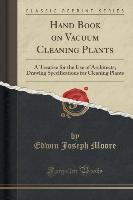- Start
- Hand Book on Vacuum Cleaning Plants
Hand Book on Vacuum Cleaning Plants
Angebote / Angebote:
Excerpt from Hand Book on Vacuum Cleaning Plants: A Treatise for the Use of Architects, Drawing Specifications for Cleaning Plants
As there are several classes of vacuum cleaning apparatus on the market it is advisable to describe the principles of operation and general construction of the various types and establish a standard rating in order to secure the desired capacity in the plant selected for given conditions and to reduce the required plant to a definite capacity rather than to take miscellaneous ratings.
Capacity - The Main Consideration in Selecting a Vacuum Cleaning Plant is to determine on A Standard Capacity. By this is meant the Amount of Air to Be Drawn Through Each Renovator (figured in cubic feet per minute), and also The Vacuum to Be Maintained to accomplish the desired results.
No two vacuum systems on the market use the same standard of capacity in making quotations, some makers bidding on equipment two to three times larger than others. Even Though They Are Rated the Same Sweeper Capacity, therefore the engineer should determine what in his opinion constitutes the proper standard of capacity and then select a plant or call for proposals on a plant of a Specified Air Displacement and Vacuum. This will compel all makers to bid on the same equipment and will assure the purchaser of getting exactly what he contemplates.
Before proceeding further, we will consider the principles of operation of a vacuum cleaning system and the various functions which are performed, and later discuss the various features.
Principle of Operation - The vacuum cleaning system consists primarily of an exhauster or vacuum-producing machine which is to create a partial vacuum in a piping system, thereby causing air to rush into the pipes to fill the void and in rushing into the pipes, carry the dirt along with it.
In a commercial unit, the building is piped with one or more vertical pipes, or "Risers, " running from basement to top floor and connected together at the basement or lowest floor and carried to the location of the pumping plant. The cleaning appliances are connected to lengths of hose which are in turn connected to inlets, or valves, situated on each riser at each floor, the openings coming out at convenient points, usually in the baseboard. This piping system is not connected to the vacuum pump, however, as in that case all the dirt would enter the pump and cause damage, therefore the pipe line carrying the dirty air is carried direct to the dirt collector or "Separator, " and after passing through this tank and becoming purified the air passes to the exhauster or vacuum producer and thence through the exhaust to a vent, either up a flue or to the outside of the building.
About the Publisher
Forgotten Books publishes hundreds of thousands of rare and classic books. Find more at www.forgottenbooks.com
This book is a reproduction of an important historical work. Forgotten Books uses state-of-the-art technology to digitally reconstruct the work, preserving the original format whilst repairing imperfections present in the aged copy. In rare cases, an imperfection in the original, such as a blemish or missing page, may be replicated in our edition. We do, however, repair the vast majority of imperfections successfully, any imperfections that remain are intentionally left to preserve the state of such historical works.
Folgt in ca. 5 Arbeitstagen
